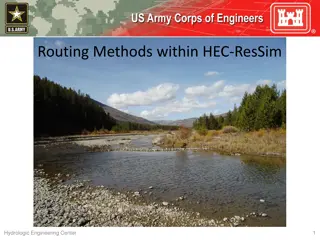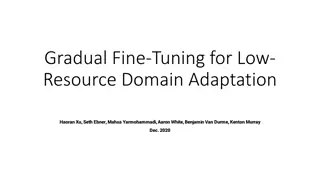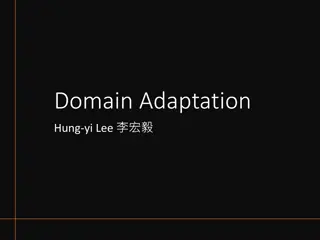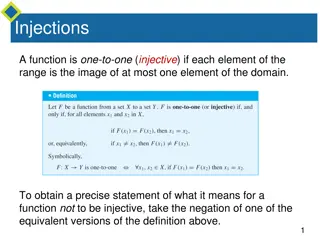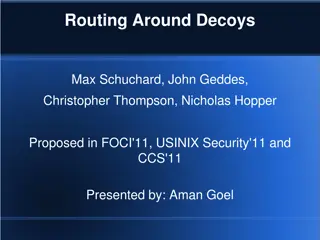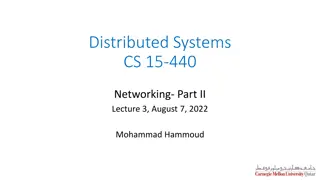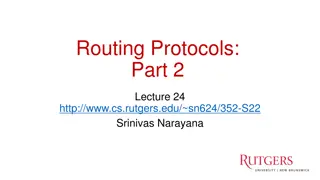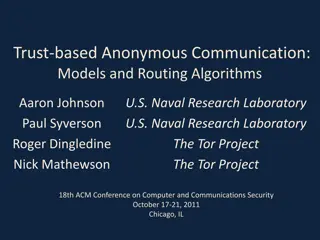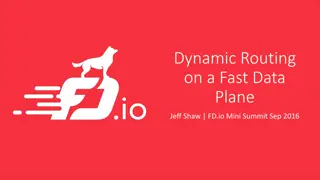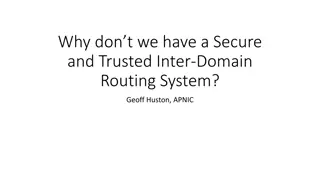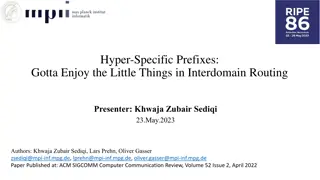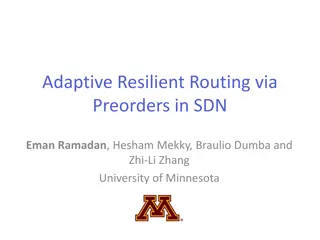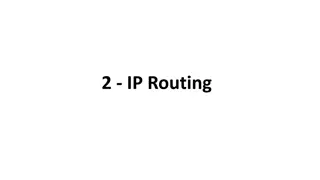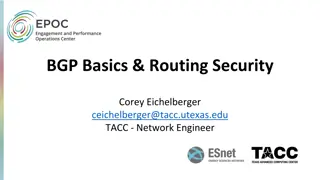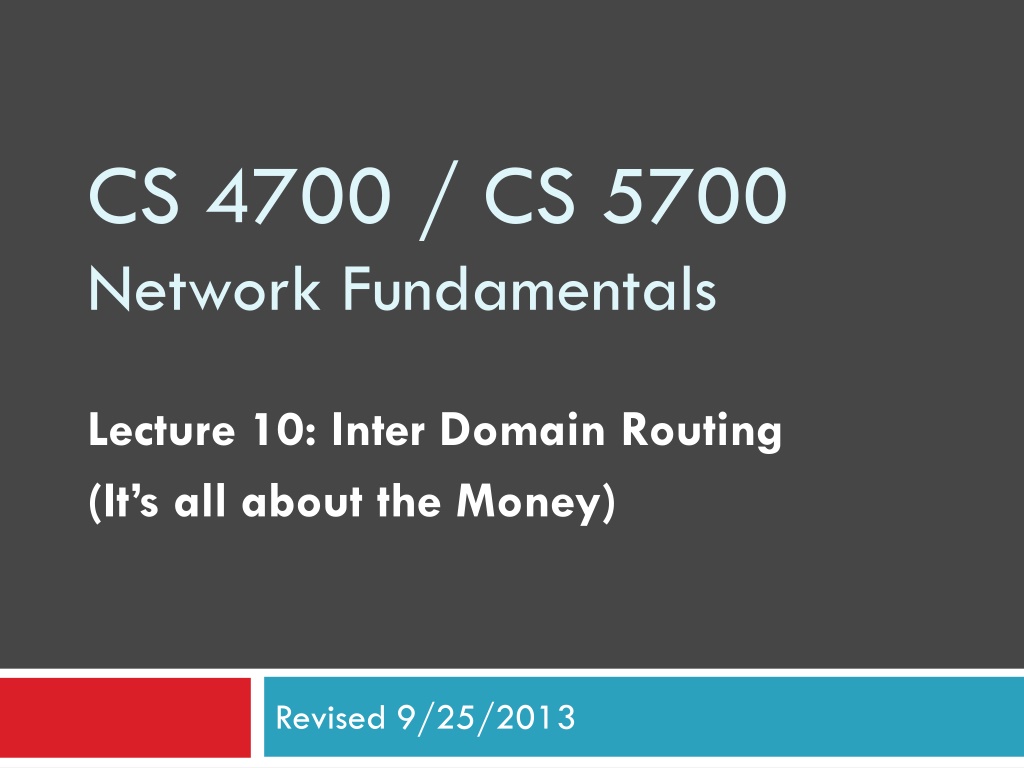
Network Fundamentals Lecture on Inter-Domain Routing
Explore key concepts of inter-domain routing like BGP, AS numbers, and the requirements for global connectivity. Learn about BGP basics, relationships in routing, tier-1 ISP peering, and the significance of stable paths in network management.
Uploaded on | 0 Views
Download Presentation

Please find below an Image/Link to download the presentation.
The content on the website is provided AS IS for your information and personal use only. It may not be sold, licensed, or shared on other websites without obtaining consent from the author. If you encounter any issues during the download, it is possible that the publisher has removed the file from their server.
You are allowed to download the files provided on this website for personal or commercial use, subject to the condition that they are used lawfully. All files are the property of their respective owners.
The content on the website is provided AS IS for your information and personal use only. It may not be sold, licensed, or shared on other websites without obtaining consent from the author.
E N D
Presentation Transcript
CS 4700 / CS 5700 Network Fundamentals Lecture 10: Inter Domain Routing (It s all about the Money) Revised 9/25/2013
Network Layer, Control Plane 2 Function: Set up routes between networks Data Plane Key challenges: Implementing provider policies Creating stable paths Application Presentation Session Transport Network Data Link Physical Control Plane RIP OSPF BGP
Outline 3 BGP Basics Stable Paths Problem BGP in the Real World Next-gen Routing: HLP
ASs, Revisited 4 AS-1 AS-3 Interior Routers AS-2 BGP Routers
AS Numbers 5 Each AS identified by an ASN number 16-bit values 64512 65535 are reserved Currently, there are > 20000 ASNs AT&T: 5074, 6341, 7018, Sprint: 1239, 1240, 6211, 6242, Northeastern: 156 North America ASs ftp://ftp.arin.net/info/asn.txt
Inter-Domain Routing 6 Global connectivity is at stake! Thus, all ASs must use the same protocol Contrast with intra-domain routing What are the requirements? Scalability Flexibility in choosing routes Cost Routing around failures Question: link state or distance vector? Trick question: BGP is a path vector protocol
BGP 7 Border Gateway Protocol De facto inter-domain protocol of the Internet Policy based routing protocol Uses a Bellman-Ford path vector protocol Relatively simple protocol, but Complex, manual configuration Entire world sees advertisements Errors can screw up traffic globally Policies driven by economics How much $$$ does it cost to route along a given path? Not by performance (e.g. shortest paths)
BGP Relationships 8 Provider Peer 2 has no incentive to route 1 3 Peers do not pay each other Peer 3 Customer Peer 1 Customer Provider Peer 2 Customer pays provider Customer
Tier-1 ISP Peering 9 Inteliquent Centurylink Verizon Business AT&T Sprint Level 3 XO Communications
Peering Wars 11 Peer Don t Peer Reduce upstream costs You would rather have customers Improve end-to-end performance Peers are often competitors May be the only way to connect to parts of the Internet Peering agreements require periodic renegotiation Peering struggles in the ISP world are extremely contentions, agreements are usually confidential
Two Types of BGP Neighbors 12 Exterior routers also speak IGP IGP eBGP eBGP iBGP iBGP
Full iBGP Meshes 13 Question: why do we need iBGP? OSPF does not include BGP policy info Prevents routing loops within the AS eBGP iBGP iBGP updates do not trigger announcements
Path Vector Protocol 14 AS-path: sequence of ASs a route traverses Like distance vector, plus additional information Used for loop detection and to apply policy AS 4 Default choice: route with fewest # of ASs 120.10.0.0/16 AS 3 130.10.0.0/16 AS 5 AS 2 110.10.0.0/16 120.10.0.0/16: AS 2 AS 3 AS 4 130.10.0.0/16: AS 2 AS 3 110.10.0.0/16: AS 2 AS 5 AS 1
BGP Operations (Simplified) 15 Establish session on TCP port 179 AS-1 Exchange active routes AS-2 Exchange incremental updates
Four Types of BGP Messages 16 Open: Establish a peering session. Keep Alive: Handshake at regular intervals. Notification: Shuts down a peering session. Update: Announce new routes or withdraw previously announced routes. announcement = IP prefix + attributes values
BGP Attributes 17 Attributes used to select best path LocalPREF Local preference policy to choose most preferred route Overrides default fewest AS behavior Multi-exit Discriminator (MED) Specifies path for external traffic destined for an internal network Chooses peering point for your network Import Rules What route advertisements do I accept? Export Rules Which routes do I forward to whom?
18 Route Selection Summary 18 Highest Local Preference Enforce relationships Shortest AS Path Lowest MED Lowest IGP Cost to BGP Egress Traffic engineering When all else fails, break ties Lowest Router ID
Shortest AS Path != Shortest Path 19 9 hops 2 ASs 4 hops 4 ASs Source Destination
Hot Potato Routing 20 5 hops total, 2 hops cost Source 3 hops total, 3 hops cost Destination
Importing Routes 21 ISP Routes From Provider From Peer From Peer From Customer
Exporting Routes 22 $$$ generating routes Customer and ISP routes only To Provider To Peer To Peer To Customer Customers get all routes
Outline 23 BGP Basics Stable Paths Problem BGP in the Real World Next-gen Routing: HLP
24 What Problem is BGP Solving? 24 Underlying Problem Shortest Paths ??? Distributed Solution RIP, OSPF, IS-IS, etc. BGP Knowing ??? can: Aid in the analysis of BGP policy Aid in the design of BGP extensions Help explain BGP routing anomalies Give us a deeper understanding of the protocol
The Stable Paths Problem 25 An instance of the SPP: Graph of nodes and edges Node 0, called the origin A set of permitted paths from each node to the origin Each set contains the null path Each set of paths is ranked Null path is always least preferred 2 1 0 2 0 5 2 1 0 5 2 2 4 2 0 4 3 0 4 0 1 3 3 0 1 3 0 1 0
A Solution to the SPP 26 A solution is an assignment of permitted paths to each node such that: Node u s path is either null or uwP, where path uw is assigned to node w and edge u w exists Each node is assigned the higest ranked path that is consistent with their neighbors 2 1 0 2 0 5 2 1 0 5 2 Solutions need not use the shortest paths, or form a spanning tree 2 4 2 0 4 3 0 4 0 1 3 3 0 1 3 0 1 0
Simple SPP Example 27 1 0 1 3 0 2 0 2 1 0 1 2 2 Each node gets its preferred route Totally stable topology 0 3 4 3 0 4 3 0 4 2 0 4 3 0 4 2 0
Good Gadget 28 1 3 0 1 0 2 1 0 2 0 1 2 2 Not every node gets preferred route Topology is still stable Only one stable configuration No matter which router chooses first! 0 3 4 3 0 4 3 0 4 2 0
SPP May Have Multiple Solutions 29 1 2 0 1 0 1 2 0 1 0 1 2 0 1 0 1 1 1 0 0 0 2 2 2 2 1 0 2 0 2 1 0 2 0 2 1 0 2 0
Bad Gadget 30 1 3 0 1 0 2 1 0 2 0 That was only one round of oscillation! This keeps going, infinitely Problem stems from: Local (not global) decisions Ability of one node to improve its path selection 1 2 2 0 3 4 3 4 2 0 3 0 4 2 0 4 3 0
SPP Explains BGP Divergence 31 BGP is not guaranteed to converge to stable routing Policy inconsistencies may lead to livelock Protocol oscillation Solvable Can Diverge Good Gadgets Bad Gadgets Must Converge Must Diverge Naughty Gadgets
Beware of Backup Policies 32 1 3 0 1 0 2 1 0 2 0 1 2 2 BGP is not robust It may not recover from link failure 0 3 4 3 4 2 0 3 0 4 0 4 2 0 4 3 0
BGP is Precarious 33 If node 1 uses path 1 0, this is solvable 4 3 1 0 4 5 3 1 2 0 4 3 1 2 0 1 2 0 1 0 4 1 3 1 0 3 1 2 0 No longer stable 3 0 5 6 2 5 3 1 0 5 6 3 1 2 0 5 3 1 2 0 6 3 1 0 6 4 3 1 2 0 6 3 1 2 0 2 1 0 2 0
Can BGP Be Fixed? 34 Unfortunately, SPP is NP-complete Possible Solutions Static Approach Dynamic Approach Extend BGP to detecting and suppress policy-based oscillations? Automated Analysis of Routing Policies (This is very hard) Inter-AS coordination These approaches are complementary
Outline 35 BGP Basics Stable Paths Problem BGP in the Real World Next-gen Routing: HLP
Motivation 36 Routing reliability/fault-tolerance on small time scales (minutes) not previously a priority Transaction oriented and interactive applications (e.g. Internet Telephony) will require higher levels of end-to- end network reliability How well does the Internet routing infrastructure tolerate faults?
Conventional Wisdom 37 Internet routing is robust under faults Supports path re-routing Path restoration on the order of seconds BGP has good convergence properties Does not exhibit looping/bouncing problems of RIP Internet fail-over will improve with faster routers and faster links More redundant connections (multi-homing) will always improve fault-tolerance
Delayed Routing Convergence 38 Conventional wisdom about routing convergence is not accurate Measurement of BGP convergence in the Internet Analysis/intuition behind delayed BGP routing convergence Modifications to BGP implementations which would improve convergence times
Open Question 39 After a fault in a path to multi-homed site, how long does it take for majority of Internet routers to fail-over to secondary path? Route Withdrawn Routing table convergence Stable end-to-end paths Primary ISP Customer Traffic Backup ISP
Bad News 40 With unconstrained policies: Divergence Possible create unsatisfiable policies NP-complete to identify these policies Happening today? With constrained policies (e.g. shortest path first) Transient oscillations BGP usually converges It may take a very long time This paper is about constrained policies
16 Month Study of Convergence 41 Instrument the Internet Inject BGP faults (announcements/withdrawals) of varied prefix and AS path length into topologically and geographically diverse ISP peering sessions Monitor impact faults through Recording BGP peering sessions with 20 tier1/tier2 ISPs Active ICMP measurements (512 byte/second to 100 random web sites) Wait two years (and 250,000 faults)
Measurement Architecture 42 Researchers pretending to be an AS Researchers pretending to be an AS
Announcement Scenarios 43 Tup a new route is advertised Tdown A route is withdrawn i.e. single-homed failure Tshort Advertise a shorter/better AS path i.e. primary path repaired Tlong Advertise a longer/worse AS path i.e. primary path fails
Major Convergence Results 44 Routing convergence requires an order of magnitude longer than expected 10s of minutes Routes converge more quickly following Tup/Repair than Tdown/Failure events Bad news travels more slowly Withdrawals (Tdown) generate several more announcements than new routes (Tup)
Example 45 BGP log of updates from AS2117 for route via AS2129 One withdrawal triggers 6 announcements and one withdrawal from 2117 Increasing AS path length until final withdrawal
Why So Many Announcements? 46 Events from AS 2177 1. 2. 3. 4. 5. 6. Route Fails: AS 2129 Announce: 5696 2129 Announce: 1 5696 2129 Announce: 2041 3508 2129 Announce: 1 2041 3508 2129 Route Withdrawn: 2129 AS 2041 AS 3508 AS 1 AS 5696 AS 2129 AS 2117
How Many Announcements Does it Take For an AS to Withdraw a Route? 47 Answer: up to 19
BGP Routing Table Convergence Times 100 90 Cumulative Percentage of Events 80 70 60 Tup Tshort Tlong Tdown 50 40 30 20 10 0 0 20 40 60 80 100 120 140 160 Seconds Until Convergence Less than half of Tdown events converge within two minutes Tup/Tshort and Tdown/Tlong form equivalence classes Long tailed distribution (up to 15 minutes)
Failures, Fail-overs and Repairs 49 Bad news does not travel fast Repairs (Tup) exhibit similar convergence as long-short AS path fail- over Failures (Tdown) and short-long fail-overs (e.g. primary to secondary path) also similar Slower than Tup (e.g. a repair) 80% take longer than two minutes Fail-over times degrade the greater the degree of multi- homing
Intuition for Delayed Convergence 50 There exists possible ordering of messages such that BGP will explore ALL possible AS paths of ALL possible lengths BGP is O(N!), where N number of default-free BGP routers in a complete graph with default policy

